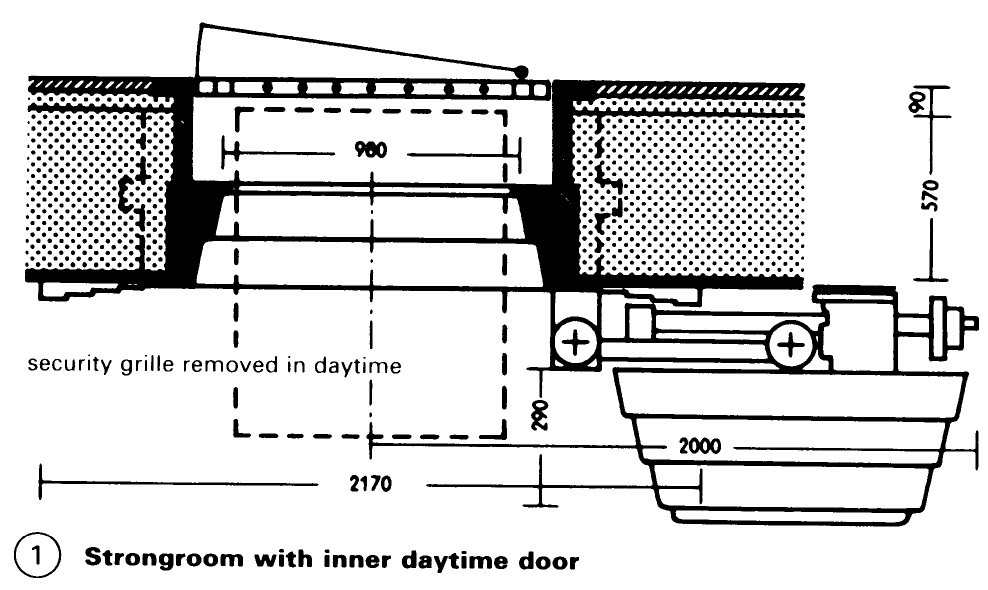Banks and Building Societies. Safes and Strongrooms
In general, wall safes are metal boxes built into the walls and hidden behind wallpaper or a painting. They are used to protect valuables in both domestic properties and business premises. – (1) – (2).

To store valuable and confidential paperwork securely, businesses make use of steel document cabinets - (3), many of which also contain a safe and are fireproof. Floor safes are used for secure storage of petty cash and documents Valuables that are rarely used are best kept in a rented safety deposit box in the strongroom of a bank - (6).


Bank strongrooms should be designed to prevent criminals from breaking in forceably. The enclosing structure and door must be able to resist penetration for sufficient time to thwart potential intruders. Structures enclosing strongrooms should, therefore, neither adjoin neighbouring spaces (i.e. no party walls) nor be built in seldom-used areas of the bank, and must not have earth below. Experience has shown that intruders otherwise have ample time to work in the unsupervised location and reduce the wall to a thin layer that can then be quickly broken through. Therefore, if a strongroom is not surrounded on all sides, including above and below, by parts of the bank that are in constant use, it must be an independent structure that is surrounded by a free space allowing full supervision.
Tests have shown that a 1:3 mix concrete with specific mineral additives offers better protection than masonry. A proficient mason equipped with sharp chisels would need over 12 hours to break through a 40cm thick wall of that type, compared with only 9 hours for a hard-fired brick wall with 1:3 mortar. Iron reinforcement barely slows down a thief (hardened rods can be broken with a hammer and normal rods can be cut out) so the added cost is not justified.
The most economical way to enclose a strongroom is by 50cm of 1:4 concrete, which would require 20 hours to break through. Assuming an 8 hour working day, a thief would have only 16 hours available. However, in the worst case, with a Sunday and two holidays, thieves could have 88 hours and since modern electric and pneumatic drills are increasingly powerful, strongrooms are always vulnerable. Therefore, they should be inspected frequently outside of official business hours and this can be done using electronic listening devices that can notify the watchman's station at the bank, or the closest police station, of the slightest noise occurring outside of business hours.
Strongroom doors. To withstand any attack, strongroom doors are made from toughened steel plate with fireproof and non-melting reinforcement, and are typically 27-30cm thick. The armoured doors pivot smoothly on steel hinges and the edges are machined to fit exactly into the reinforced door surround. They do not have keyholes, instead using elaborate remote-controlled locking devices, and are usually protected by electrically operated alarm systems that are triggered by the slightest vibration of door.

Cashier positions. The cashiers' counter is provided with an electric alarm system operated by foot or knee to guard against potential attack. Money is held securely in standard steel cabinets, usually underneath the counter.


Drive-in banks. To save time, customers do not go into bank but drive up to an external cash point that may either be manned or automated. This avoids parking problems. The cash points can be integrated in bank building or built separately on islands. Each cash point can serve up to 250 customers per day; transactions can take as little as 60 seconds. However, a normal banking hall is also needed for lengthier business transactions.
Date added: 2023-01-05; views: 653;
